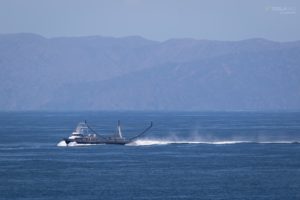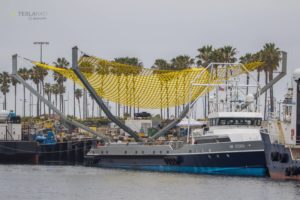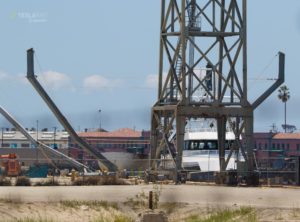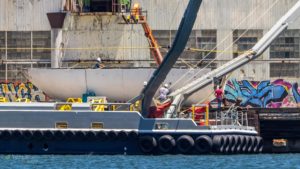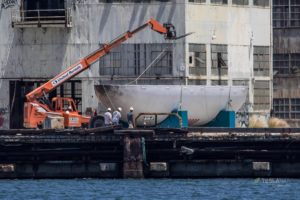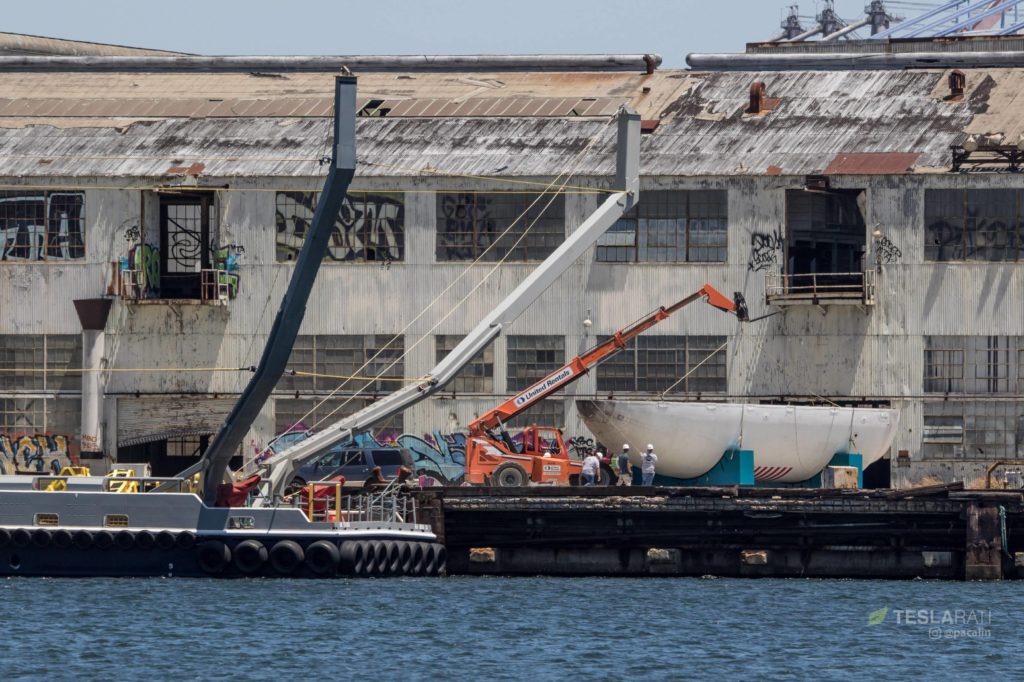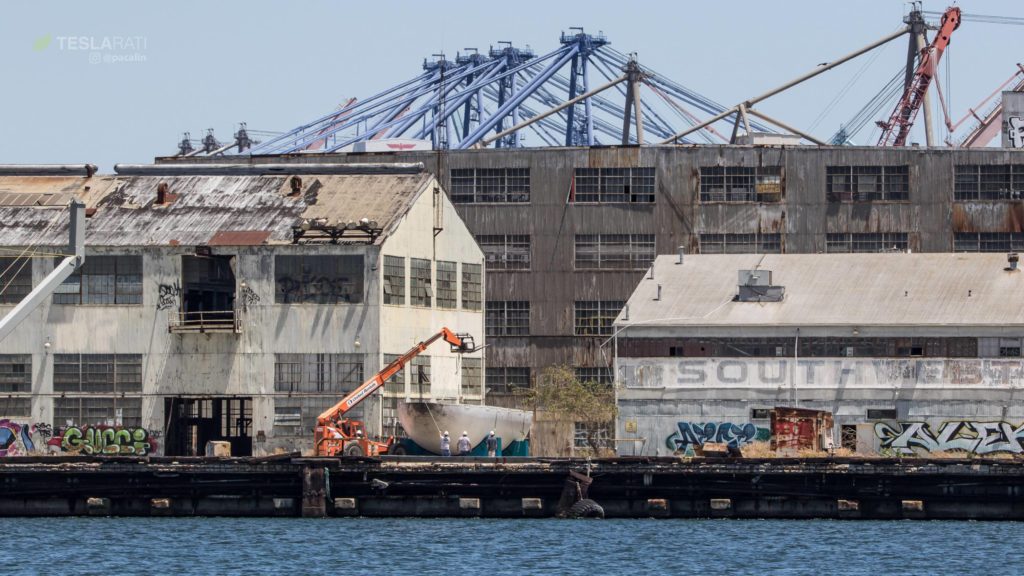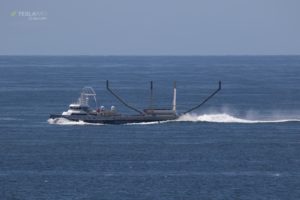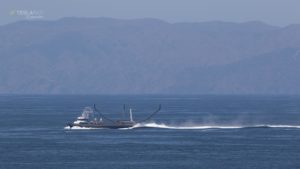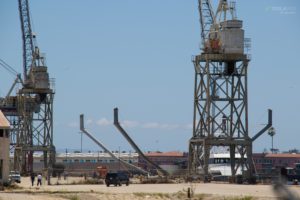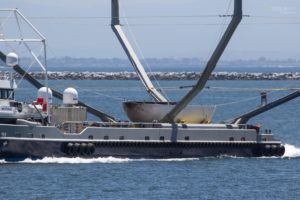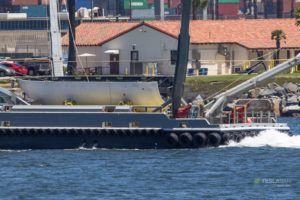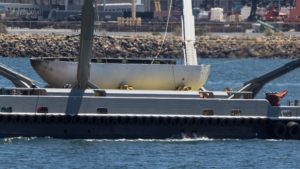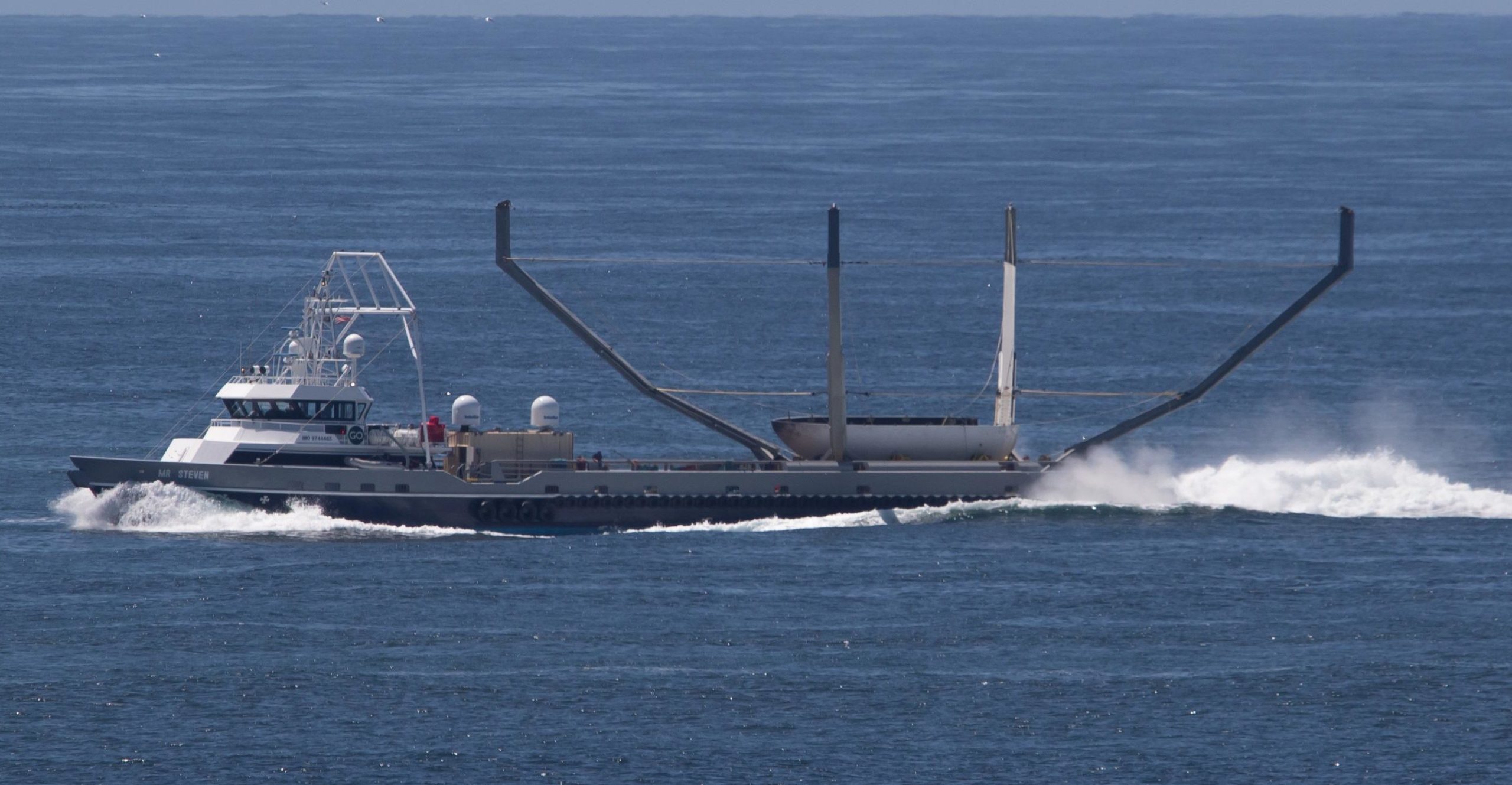
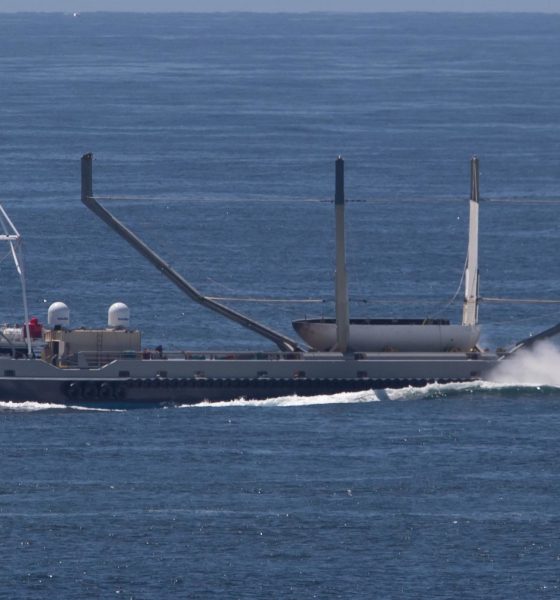
SpaceX
SpaceX rocket fairing reappears on Mr Steven after six week hiatus
A hop and a skip away from SpaceX’s first Falcon 9 Block 5 recovery, the company’s famous fairing recovery vessel Mr Steven was caught by Teslarati photographer Pauline Acalin performing some unusual maneuvers at sea, hauling what can only have been the intact fairing half recovered after SpaceX’s March 30 launch of Iridium NEXT-5.
Why exactly the fairing half was aboard Mr Steven for high-speed trials and eventual delivery to Berth 240 – SpaceX’s future Mars rocket factory – is not entirely clear. The most obvious explanation is that these new operations are in some way related to Falcon 9 payload fairing drop tests hinted at recently by CEO Elon Musk, tests that would allow the company to hone the accuracy of the autonomous parafoils currently used to recover them. In light of Mr Steven’s newly upgraded net, the goal is to gently catch each fairing before they touch down on the ocean’s surface – per SpaceX’s Hans Koenigsmann, even partial immersion in seawater precludes any future attempts at reuse.

SpaceX technicians offload the Iridium fairing half from Mr Steven while docked at Berth 240, SpaceX’s BFR (Mars rocket) factory in-waiting. (Pauline Acalin)
While we originally speculated that water intrusion into the fairing halves’ aluminum honeycomb composite structures – a common failure mode in the history of the material’s use in aerospace – would pose a problem for fairing reuse sans net capture, the actual reason Koenigsmann gave was the fact that the environment inside Falcon fairings must be kept extraordinarily clean to avoid damaging the highly sensitive satellite and spacecraft payloads housed inside. In retrospect, it makes a whole lot of sense that cleaning a fairing thoroughly enough after exposure to seawater/sea spray and its multitudes of organic material, minerals, and simple saltwater could pose an extremely expensive (if not outright intractable) problem for routine reusability. Hence Mr Steven and his wonderfully analog recovery hardware (i.e. a giant net).
- Fairing aboard, Mr Steven performed rapid turns and high-speed sprints with the fairing half aboard. (Pauline Acalin)
- Mr Steven and his fancy net 2.0, caught on May 7. Bright yellow…for style. (Pauline Acalin)
- On May 16, he arrived at Berth 240 with fairing half in tow. (Pauline Acalin)
- Note the distinctive yellow netting draped over the fairing stand aboard Mr Steven. It’s unclear if this is actually the new yellow net spotted last week, or if it’s actually webbing dedicated to securing the fairing cradle. (Pauline Acalin)
- It’s unclear why the Iridium fairing has been brought once again to Berth 240, aside perhaps from temporary storage. (Pauline Acalin)
After approximately six weeks of rest after its return to Port of San Pedro aboard Mr Steven, the fairing half found itself speeding around the mouth of Port of San Pedro aboard the net boat Mr Steven on May 16, after which it was carefully offloaded at SpaceX’s recently-leased Berth 240 facilities, set to one day become the company’s first Mars rocket and spaceship factory (currently housed in a giant tent a few miles away).
A careful scan of the day’s aviation activities showed no tracked helicopter flights that could have been involved in fairing drop tests, and it’s equally implausible that SpaceX would choose (or be permitted) to attempt to catch a 1000 kg autonomous parafoil a handful of miles from densely populated Los Angeles. Mr Steven’s distinctive yellow net – a brand new upgrade – was also visibly strewn about the vessel’s deck, over top of a basic wooden fairing stand, atop of which sat the sooty Iridium fairing half. Given the lengthy journey, it has made to be aboard Mr Steven, May 16’s unusual day of testing is presumably just the beginning of a number of outings, perhaps culminating in fairing drop and catch tests with a helicopter.
- Regardless of why it’s there, the contrast of the dilapidated urban landscape and cutting-edge flight-proven rocket hardware is absolutely breathtaking.(Pauline Acalin)
- Jump maybe 6 months ahead, and one can already begin to imagine that the first BFS test article may end up being craned aboard a barge before the exact same backdrop. (Pauline Acalin)
Regardless, the whole event was an incredible spectacle, caught in awesome detail by Pauline Acalin. One can only begin to imagine what other sights might one day – perhaps fairly soon – grace the dramatic dockside space SpaceX now owns at Berth 240.
- It’s difficult to imagine how Mr Steven’s already vast net could plausibly be expanded by a factor of two in each dimension. I certainly can’t wait to see how SpaceX engineers and technicians tackle the task. (Pauline Acalin)
- Fairing aboard, Mr Steven performed rapid turns and high-speed sprints with the fairing half aboard. (Pauline Acalin)
- Mr Steven and the Iridium fairing half berthed at SpaceX’s Berth 240. (Pauline Acalin)
- Mr Steven returns to port with the Iridium fairing half aboard. (Pauline Acalin)
- Mr Steven out and about with a recovered but unreusable fairing half in May 2018, presumably for some sort of practice. (Pauline Acalin)
- Mr Steven returns to port with the Iridium fairing half aboard. (Pauline Acalin)
Follow us for live updates, behind-the-scenes sneak peeks, and a sea of beautiful photos from our East and West coast photographers.
Teslarati – Instagram – Twitter
Tom Cross – Twitter
Pauline Acalin – Twitter
Eric Ralph – Twitter

News
SpaceX shades airline for seeking contract with Amazon’s Starlink rival

SpaceX employees, including its CEO Elon Musk, shaded American Airlines on social media this past weekend due to the company’s reported talks with Amazon’s Starlink rival, Leo.
Starlink has been adopted by several airlines, including United Airlines, Qatar Airways, Hawaiian Airlines, WestJet, Air France, airBaltic, and others. It has gained notoriety as an extremely solid, dependable, and reliable option for airline travel, as traditional options frequently cause users to lose connection to the internet.
Many airlines have made the switch, while others continue to mull the options available to them. American Airlines is one of them.
A report from Bloomberg indicates the airline is thinking of going with a Starlink rival owned by Amazon, called Leo. It was previously referred to as Project Kuiper.
American CEO Robert Isom said (via Bloomberg):
“While there’s Starlink, there are other low-Earth-orbit satellite opportunities that we can look at. We’re making sure that American is going to have what our customers need.”
Isom also said American has been in touch with Amazon about installing Leo on its aircraft, but he would not reveal the status of any discussions with the company.
The report caught the attention of Michael Nicolls, the Vice President of Starlink Engineering at SpaceX, who said:
“Only fly on airlines with good connectivity… and only one source of good connectivity at the moment…”
CEO Elon Musk replied to Nicolls by stating that American Airlines risks losing “a lot of customers if their connectivity solution fails.”
American Airlines will lose a lot of customers if their connectivity solution fails
— Elon Musk (@elonmusk) December 14, 2025
There are over 8,000 Starlink satellites in orbit currently, offering internet coverage in over 150 countries and territories globally. SpaceX expands its array of satellites nearly every week with launches from California and Florida, aiming to offer internet access to everyone across the globe.
Currently, the company is focusing on expanding into new markets, such as Africa and Asia.
News
Tesla hints at Starlink integration with recent patent
“By employing polymer blends, some examples enable RF transmission from all the modules to satellites and other communication devices both inside and outside the vehicle.”

Tesla hinted at a potential Starlink internet terminal integration within its vehicles in a recent patent, which describes a vehicle roof assembly with integrated radio frequency (RF) transparency.
The patent, which is Pub. No U.S. 2025/0368267 describes a new vehicle roof that is made of RF-transparent polymer materials, allowing and “facilitating clear communication with external devices and satellites.”
Tesla believes that a new vehicle roof design, comprised of different materials than the standard metallic or glass elements used in cars today, would allow the company to integrate modern vehicular technologies, “particularly those requiring radio frequency transmission and reception.
Tesla has recently filed a US patent application on integrating RF transparent materials into the roof structure.
“facilitating clear communication with external devices and satellites”
Tesla fleet is getting @Starlink connectivity integration soon. LFG @Tesla @elonmusk… pic.twitter.com/bLa8YtPLd1
— Chansoo Byeon (@Chansoo) December 9, 2025
Instead of glass or metallic materials, Tesla says vehicles may benefit from high-strength polymer blends, such as Polycarbonate, Acrylonitrile Butadiene Styrene, or Acrylonitrile Styrene Acrylate.
These materials still provide ideal strength metrics for crashworthiness, stiffness for noise, vibration, and harshness control, and are compliant with head impact regulations.
They would also enable better performance with modern technologies, like internet terminals, which need an uninterrupted signal to satellites for maximum reception. Tesla writes in the patent:
“By employing polymer blends, some examples enable RF transmission from all the modules to satellites and other communication devices both inside and outside the vehicle.”

One of the challenges Tesla seems to be aware of with this type of roof design is the fact that it will still have to enable safety and keep that at the forefront of the design. As you can see in the illustration above, Tesla plans to use four layers to increase safety and rigidity, while also combating noise and vibration.
It notes in the patent that disclosed examples still meet the safety requirements outlined in the Federal Motor Vehicle Safety Standards (FMVSS).
Starlink integrated directly into Tesla vehicles would be a considerable advantage for owners. It would come with a handful of distinct advantages.
Initially, the inclusion of Starlink would completely eliminate cellular dead zones, something that is an issue, especially in rural areas. Starlink would provide connectivity in these remote regions and would ensure uninterrupted service during road trips and off-grid adventures.
It could also be a critical addition for Robotaxi, as it is crucial to have solid and reliable connectivity for remote monitoring and fleet management.
Starlink’s growing constellation, thanks to SpaceX’s routine and frequent launch schedule, will provide secure, stable, and reliable internet connectivity for Tesla vehicles.
Although many owners have already mounted Starlink Mini dishes under their glass roofs for a similar experience, it may be integrated directly into Teslas in the coming years, either as an upgrade or a standard feature.
Investor's Corner
SpaceX IPO is coming, CEO Elon Musk confirms
However, it appears Musk is ready for SpaceX to go public, as Ars Technica Senior Space Editor Eric Berger wrote an op-ed that indicated he thought SpaceX would go public soon. Musk replied, basically confirming it.

Elon Musk confirmed through a post on X that a SpaceX initial public offering (IPO) is on the way after hinting at it several times earlier this year.
It also comes one day after Bloomberg reported that SpaceX was aiming for a valuation of $1.5 trillion, adding that it wanted to raise $30 billion.
Musk has been transparent for most of the year that he wanted to try to figure out a way to get Tesla shareholders to invest in SpaceX, giving them access to the stock.
He has also recognized the issues of having a public stock, like litigation exposure, quarterly reporting pressures, and other inconveniences.
However, it appears Musk is ready for SpaceX to go public, as Ars Technica Senior Space Editor Eric Berger wrote an op-ed that indicated he thought SpaceX would go public soon.
Musk replied, basically confirming it:
As usual, Eric is accurate
— Elon Musk (@elonmusk) December 10, 2025
Berger believes the IPO would help support the need for $30 billion or more in capital needed to fund AI integration projects, such as space-based data centers and lunar satellite factories. Musk confirmed recently that SpaceX “will be doing” data centers in orbit.
AI appears to be a “key part” of SpaceX getting to Musk, Berger also wrote. When writing about whether or not Optimus is a viable project and product for the company, he says that none of that matters. Musk thinks it is, and that’s all that matters.
It seems like Musk has certainly mulled something this big for a very long time, and the idea of taking SpaceX public is not just likely; it is necessary for the company to get to Mars.
The details of when SpaceX will finally hit that public status are not known. Many of the reports that came out over the past few days indicate it would happen in 2026, so sooner rather than later.
But there are a lot of things on Musk’s plate early next year, especially with Cybercab production, the potential launch of Unsupervised Full Self-Driving, and the Roadster unveiling, all planned for Q1.
